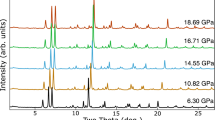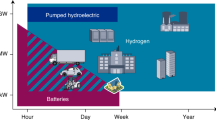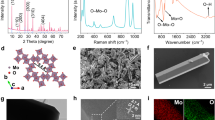Abstract
ELECTRODES of palladium and palladium alloys can absorb large volumes of hydrogen. In general, the solid hydrides retain excellent electrical conductivity and are not severely embrittled or disrupted. For pure palladium, and for many alloys, the relationships between electrodo potential E (with respect to a hydrogen reference electrode in the same solution) and hydrogen content (written here. Fig. 1, as the ratio, H/Me, of hydrogen atoms to the total number of metal atoms) exhibit ‘plateau’ regions—over which α- and β-phase hydrides co-exist—where E is relatively invariant (Eα,β). Over such ‘plateau’ regions, hydrogen transfer should, in principle, occur at a constant rate when connexion is made between an alloy and palladium or between two alloys. However, polarization1 would be expected to occur rapidly if the diffusion of hydrogen within the electrodes were not sufficiently fast for the concentration of hydrogen at the surfaces to be continuously representative of the ranges of H/Me corresponding to the plateaux. The following experiments serve to illustrate what may be observed in practice.
This is a preview of subscription content, access via your institution
Access options
Subscribe to this journal
Receive 51 print issues and online access
$199.00 per year
only $3.90 per issue
Buy this article
- Purchase on Springer Link
- Instant access to full article PDF
Prices may be subject to local taxes which are calculated during checkout
Similar content being viewed by others
References
Carson, A. W., Flanagan, T. B., and Lewis, F. A., Trans. Farad. Soc., 56, 363, 371, 1311, 1324, 1332 (1960).
Vert, Z. L., and Tverdovskii, I. P., Zhur. Fiz Khim., 28, 317 (1954).
Lewis, F. A., and Schurter, W. H., Naturwiss., 47, 177 (1960).
Barton, J. C., and Lewis, F. A., Trans. Farad. Soc., 58, 103 (1962).
Kandler, L., Knorr, C. A., and Schwitzer, E., Z. physik. Chem. (Leipzig), A, 180, 281 (1937).
Flanagan, T. B., and Lewis, F. A., J. Electrochem. Soc., 108, 473 (1961).
Barton, J. C., and Lewis, F. A., Z. physik. Chem., Neue Folge, 33, 99 (1962).
Author information
Authors and Affiliations
Rights and permissions
About this article
Cite this article
BARTON, J., GREEN, J. & LEWIS, F. Electrical Storage and Hydrogen Transfer between Electrodes of Palladium and Palladium Alloys. Nature 197, 1293–1294 (1963). https://doi.org/10.1038/1971293b0
Issue Date:
DOI: https://doi.org/10.1038/1971293b0
Comments
By submitting a comment you agree to abide by our Terms and Community Guidelines. If you find something abusive or that does not comply with our terms or guidelines please flag it as inappropriate.



